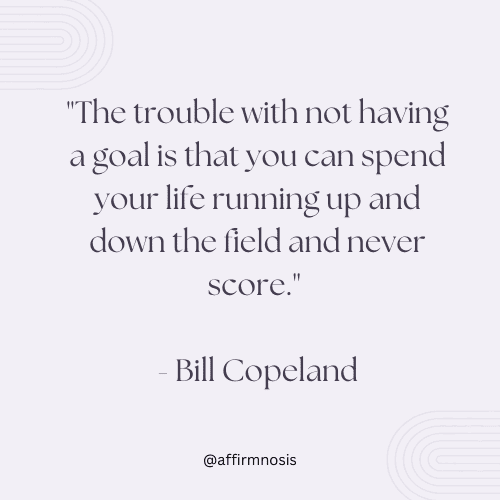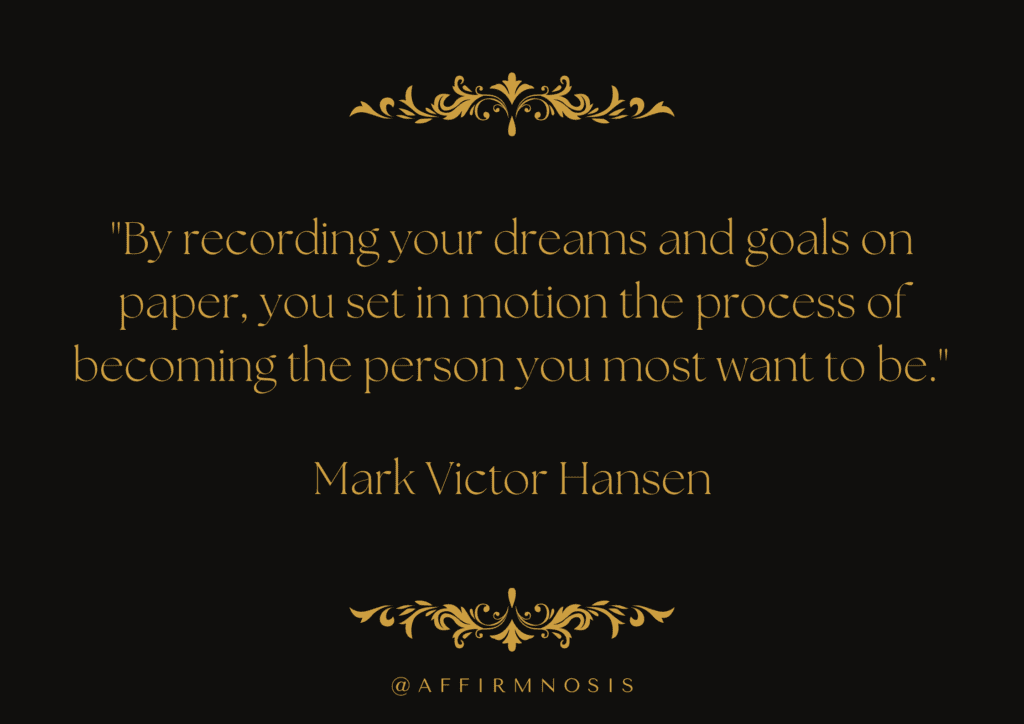Goal setting is the process of identifying what you want to achieve and establishing measurable objectives that will eventually lead you to your desired destination. It is a crucial aspect of personal development, motivation, and success in any area of life.
The Power of Goal Setting with Self-Hypnosis
Goal setting may seem like an easy task, but it requires careful planning and strategizing to accomplish it effectively. The importance of goal setting cannot be overemphasized.
It provides a sense of direction and purpose, helps one focus on what matters most, and enables individuals to prioritize their time, energy, and effort towards achieving their desired outcomes. Without goals, people tend to drift aimlessly through life without a clear sense of direction or accomplishment.
Self-hypnosis is a powerful tool that can be used alongside goal setting to help achieve positive results faster and more easily than traditional methods alone. Self-hypnosis has been used for centuries as a tool for personal development and self-improvement by people from all walks of life.
What is Self-Hypnosis?
Self-hypnosis is a state in which an individual induces themselves into a trance-like state through relaxation techniques such as deep breathing or visualization exercises. In this state, the conscious mind becomes relaxed while the subconscious mind becomes more open to suggestion.
During self-hypnosis sessions that focus on goal setting, individuals can access their subconscious minds where they can plant positive suggestions that will help them reach their goals faster than with traditional methods alone.
The Benefits of Self-Hypnosis for Goal Setting
The benefits of self-hypnosis are numerous when it comes to goal-setting. First off, self-hypnosis helps individuals combat negative thoughts or limiting beliefs that may be standing in the way of reaching their goals.
By accessing the subconscious mind through self-hypnosis, individuals can reprogram their thinking patterns to be more optimistic and supportive of their goals. Secondly, self-hypnosis helps individuals visualize their desired outcomes in a powerful and effective way.
Visualization is a key aspect of goal setting as it helps an individual create a clear mental picture of what they want to achieve. By visualizing their goals during self-hypnosis sessions, individuals can experience the feelings associated with achieving those goals in advance, which makes it easier for them to manifest those outcomes in real life.
Self-hypnosis provides individuals with a level of relaxation and calmness that is difficult to achieve through traditional goal-setting methods. The relaxation aspect of self-hypnosis helps reduce stress levels, increase energy levels and leads to better overall well-being which is crucial for successful goal attainment.
The combination of goal setting with self-hypnosis is a powerful tool for personal development and success. Self-hypnosis allows individuals to access their subconscious minds where they can plant positive suggestions that will lead them towards achieving their desired outcomes faster than traditional methods alone.
It provides numerous benefits such as combating negative thoughts or limiting beliefs while enhancing visualization capacity amongst others. The next section will discuss how one can effectively use self-hypnosis for goal setting.
Understanding Self-Hypnosis for Goal Setting
Self-hypnosis can be defined as a technique whereby an individual induces a state of deep relaxation, concentration, and focus. During this state, the individual is able to access their subconscious mind with the aim of reprogramming it to change habits, behaviors and thought patterns.
Self-hypnosis is often used in conjunction with goal setting as a tool for achieving personal growth and development.
How Self-Hypnosis can be Used for Goal Setting
Self-hypnosis can be used to achieve any kind of goal that an individual may have set for themselves. It is particularly effective in enhancing motivation, confidence and self-esteem towards achieving one’s goals.
Through self-hypnosis, individuals are able to access their subconscious mind where they can work on improving self-belief and eliminating limiting beliefs that may hinder them from achieving their goals.
By inducing a state of deep relaxation, concentration and focus through self-hypnosis, individuals are able to create a mental picture or image of themselves achieving their desired outcome.
This visualization technique helps to strengthen the neural pathways responsible for motivation towards achieving that outcome.
Benefits of Using Self-Hypnosis for Goal Setting
One benefit of using self-hypnosis for goal setting is its effectiveness in reprogramming the subconscious mind. Since most limiting beliefs or negative attitudes towards success are deeply rooted in our subconscious mind, conventional goal-setting methods may not always yield fruitful results.
Another benefit is its flexibility – individuals can practice self-hypnosis techniques at any time without necessarily having to seek assistance from a professional hypnotherapist thus saving time and money.
Self-hypnosis also provides individuals with tools that can be used beyond goal-setting. The mental skills developed during self-hypnotic practice such as heightened concentration and focus can be applied in other areas of life including work, relationships or any other activities that require mental agility.
Self-hypnosis is a non-invasive and natural method for inducing relaxation and reducing stress. Stress is often a major hindrance to goal achievement, so mastering self-hypnosis techniques will not only help in achieving one’s goals but also in managing stress levels which can improve overall quality of life.

Preparing for Self-Hypnosis for Goal Setting
Creating a Conducive Environment
Before starting your self-hypnosis session for goal setting, it is essential to create an environment that is conducive to relaxation and free from distractions.
This includes finding a quiet space where you will not be interrupted, ensuring there are no bright lights or loud noises, and preferably having a comfortable chair or cushion to sit on. It is also helpful to set the temperature in the room at a comfortable level.
This may mean adjusting the air conditioning or using blankets to keep warm if the temperature is cool. Additionally, adding relaxing elements such as soft music, scented candles, or essential oils can help put you in a relaxed state of mind.
Choosing the Right Time to Practice
Choosing the right time of day to practice self-hypnosis for goal setting can greatly impact its effectiveness. It is recommended that you schedule your sessions during a time when you are least likely to be disturbed by external factors.
This could be early in the morning before anyone else wakes up or late at night when everyone has gone to bed. It is also important to consider your own circadian rhythm.
Some people are naturally more alert in the morning while others may feel more energized later in the day. Choose a time when you feel most relaxed and focused.
Finding a Comfortable Position
Finding a comfortable position is crucial for successful self-hypnosis practice. You want to ensure that your body is fully supported so that it does not distract you during your session.
For example, if sitting cross-legged on the floor causes discomfort or pain after some time, then choose another position like sitting on an ergonomic chair with back support instead.
Alternatively, lying down on your back with cushions under your knees can be another comfortable position for practicing self-hypnosis for goal setting. Be sure to experiment with different postures until you find the one that works best for you.
The Power of Preparation
Proper preparation is key to successful self-hypnosis for goal setting. By creating a conducive environment, choosing the right time, and finding a comfortable position, you can fully immerse yourself in your practice and reap maximum benefits.
Take the time to prepare for your self-hypnosis sessions just as you would if you were preparing for any other important activity in your life.
Remember that this is an investment in yourself and your goals, so give it the attention and effort it deserves. With these preparations in place, you will be ready to embark on an exciting journey of self-discovery and personal growth through self-hypnosis.
Techniques for Self-Hypnosis for Goal Setting
Visualization Techniques: Seeing is Believing
Visualization is a powerful technique that can help you achieve your goals by creating mental images of what you want to accomplish. Visualization involves using your imagination to create a vivid mental picture of yourself successfully achieving your goal.
For example, if your goal is to lose weight, you might visualize yourself feeling healthy and confident in a new outfit or being congratulated by friends and family on reaching your target weight.
To use visualization in self-hypnosis, find a quiet place where you won’t be disturbed and close your eyes. Take deep breaths and then begin to imagine yourself succeeding at your goal.
Affirmations and Positive Self-Talk: The Power of Words
Affirmations are positive statements that help you focus on the outcome you desire. They can be used as part of self-hypnosis to reprogram negative thoughts and beliefs that may have been holding you back from achieving your goals.
For example, if your goal is to start a business, an affirmation might be “I am capable of running a successful business.” You can repeat this affirmation during self-hypnosis or throughout the day as needed.
Positive self-talk involves using positive affirmations throughout the day to keep yourself motivated and focused on achieving your goals. This includes using phrases like “I can do this” or “I am strong enough to overcome any obstacle.” Positive self-talk helps reinforce positive beliefs about yourself and encourages resilience in the face of setbacks.
Anchoring Techniques: Creating Triggers for Success
Anchoring involves associating a specific physical sensation with success or achievement. This technique helps create triggers that activate feelings of confidence and motivation when they are needed most.
Anchoring techniques involve choosing a physical gesture or movement that will be associated with success.
For example, you might choose to clasp your hands together when you feel confident or use a specific breathing pattern when you need to focus. During self-hypnosis, you can reinforce these anchors by associating them with positive affirmations and mental images of success.
Combining Techniques for Maximum Effectiveness
While each technique on its own can be effective, combining them can bring even greater results. For example, during self-hypnosis, you might use visualization to create a mental image of yourself succeeding at your goal while repeating positive affirmations and using anchoring techniques to reinforce feelings of confidence and motivation.
Experiment with different combinations of techniques to find what works best for you. By incorporating visualization techniques, affirmations and positive self-talk, anchoring techniques and combining them creatively during self-hypnosis practice sessions will help in achieving your goals quicker than expected.

Tips to Enhance the Effectiveness of Self-Hypnosis for Goal Setting
Consistency and Regularity in Practice: The Key to Success
One of the most important aspects of using self-hypnosis for goal-setting is consistency. The more consistently you practice self-hypnosis, the more effective it will be in helping you achieve your goals.
Aim to practice self-hypnosis at least once a day, preferably at the same time each day. To help with consistency, consider setting reminders or alarms on your phone or calendar so you don’t forget to practice.
Additionally, try incorporating self-hypnosis into your daily routine. For example, if you typically take a lunch break around noon, use that time to practice self-hypnosis.
Maintaining a Positive Mindset: The Power of Positivity
Maintaining a positive mindset is crucial when it comes to achieving your goals through self-hypnosis. This means focusing on what you want rather than what you don’t want and approaching challenges as opportunities for growth and learning rather than setbacks.
To maintain a positive mindset during self-hypnosis sessions, try using positive affirmations and visualization techniques.
Imagine yourself already achieving your goal and focus on how that makes you feel. Repeat positive affirmations such as “I am capable of achieving my goals” or “I am confident in my ability to succeed.”
Incorporating Physical Exercise: The Mind-Body Connection
Physical exercise has been shown to have numerous benefits for both physical and mental health, including reducing stress and increasing energy levels. Incorporating regular exercise into your routine can also enhance the effectiveness of self-hypnosis for goal-setting. When we exercise, our bodies release endorphins which improve mood and reduce stress levels.
This can help us approach our goals with a clear mind and positive attitude. Additionally, exercise can improve focus and concentration, which can be beneficial during self-hypnosis sessions.
Developing Healthy Habits: The Importance of Self-Care
It’s important to develop healthy habits outside of self-hypnosis sessions to enhance their effectiveness. This includes eating a healthy diet, getting enough sleep, and limiting unhealthy habits such as smoking or excessive alcohol consumption.
Taking care of ourselves holistically sets the stage for success in achieving our goals through self-hypnosis.
When we feel physically and mentally well, we are better equipped to handle challenges and setbacks that may arise in the pursuit of our goals. By incorporating consistency, positivity, physical exercise, and healthy habits into your routine you can enhance the effectiveness of self-hypnosis for goal-setting.
Remember that goal setting is an ongoing process and requires patience, persistence, and dedication. With these tips in mind, you’ll be well on your way to achieving your dreams through the power of self-hypnosis.
Setting Goals with Self Hypnosis for a Better Life
Goal setting is an important aspect of achieving success in life. It might seem daunting and overwhelming at first, but with the right mindset and tools, you can achieve any goal you set your mind to.
Self-hypnosis is one such tool that can help facilitate the process of goal setting and ensure that you reach your desired outcomes.
The Importance of Practicing Self Hypnosis for Goal Setting
Self-hypnosis allows you to tap into your subconscious mind and reprogram your thoughts to align with your goals. This technique can help you overcome limiting beliefs, fears, and negative self-talk that may have hindered your progress in the past. Additionally, practicing self-hypnosis regularly can improve concentration, increase focus and reduce stress levels.
Continuing Your Journey with Self Hypnosis
As discussed earlier in this article, there are various techniques to use self-hypnosis for goal setting including visualization techniques, affirmations and anchoring techniques. Incorporating these techniques into your daily routine will not only assist you in achieving your goals but also enable you to live a more fulfilling life.
With practice and consistency, self hypnosis will become an essential part of achieving all aspects of personal growth as well as professional development. It is an excellent tool for anyone determined to make positive changes happen in their lives.
The Power of Positive Thinking With Self Hypnosis
It’s worth noting that when done correctly using self hypnosis for goal setting creates a positive mindset that brings about the realization of realistic goals people set out for themselves. Using this powerful technique helps people believe they have improved chances than initially thought by unlocking their potential leading them on the path towards success.
using self hypnosis effectively eliminates limiting beliefs about oneself and replaces them with positive messages that help individuals to believe in themselves, dream big and make decisions that lead towards the right direction. Remember, the power to achieve anything you want lies within you; self-hypnosis helps unlock this power.
20 quotes from notable individuals on goal setting:
- “The trouble with not having a goal is that you can spend your life running up and down the field and never score.” – Bill Copeland
- “Setting goals is the first step in turning the invisible into the visible.” – Tony Robbins
- “A goal properly set is halfway reached.” – Zig Ziglar
- “You should set goals beyond your reach so you always have something to live for.” – Ted Turner
- “Goals. There’s no telling what you can do when you get inspired by them. There’s no telling what you can do when you believe in them. And there’s no telling what will happen when you act upon them.” – Jim Rohn
- “If you want to be happy, set a goal that commands your thoughts, liberates your energy and inspires your hopes.” – Andrew Carnegie
- “People with goals succeed because they know where they’re going.” – Earl Nightingale
- “The greater danger for most of us isn’t that our aim is too high and miss it, but that it is too low and we reach it.” – Michelangelo
- “By recording your dreams and goals on paper, you set in motion the process of becoming the person you most want to be.” – Mark Victor Hansen
- “Goals are dreams with deadlines.” – Diana Scharf Hunt
- “All successful people have a goal. No one can get anywhere unless he knows where he wants to go and what he wants to be or do.” – Norman Vincent Peale
- “You are never too old to set another goal or to dream a new dream.” – C.S. Lewis
- “The future you see is the future you get.” – Robert G Allen
- “Set your goals high, and don’t stop till you get there.” – Bo Jackson
- “Aim for the moon. If you miss, you may hit a star.” – W. Clement Stone
- “The only limit to the height of your achievements is the reach of your dreams and your willingness to work for them.” – Michelle Obama
- “The only thing standing between you and your goal is the story you keep telling yourself as to why you can’t achieve it.” – Jordan Belfort
- “What you get by achieving your goals is not as important as what you become by achieving your goals.” – Zig Ziglar
- “Set your goals high, and don’t stop till you get there.” – Bo Jackson
- “The goal is not to be better than the other man, but your previous self.” – Dalai Lama
These quotes emphasize the importance of setting goals for providing direction, inspiring action, and facilitating success.




























































